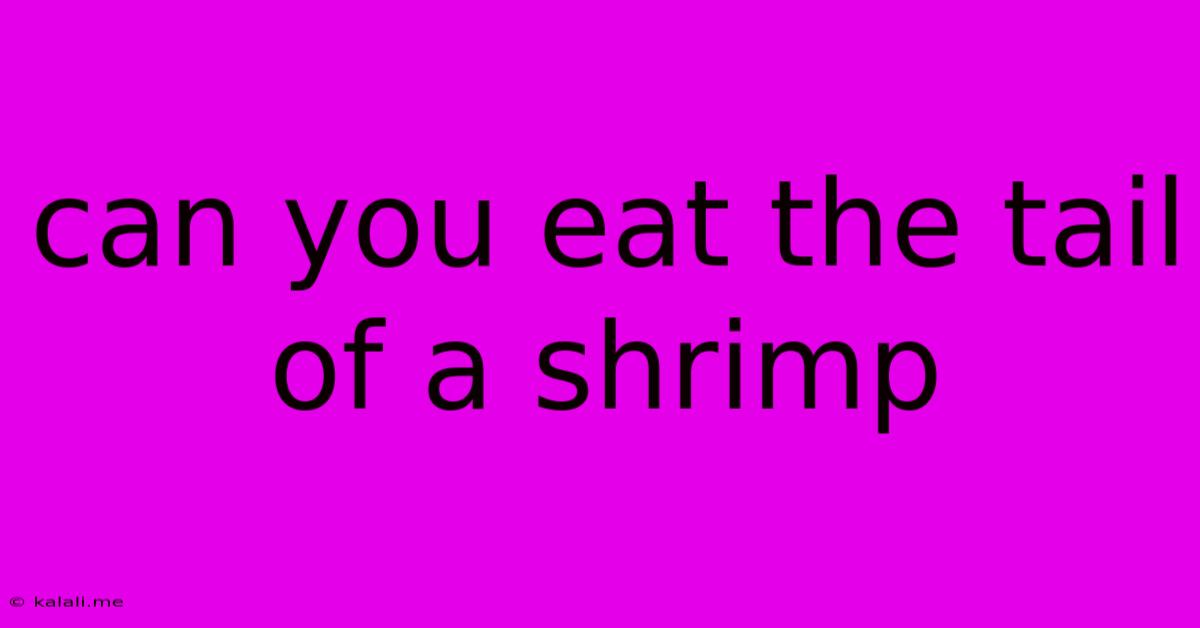Can You Eat The Tail Of A Shrimp
Kalali
Jun 08, 2025 · 3 min read

Table of Contents
Can You Eat the Shrimp Tail? A Comprehensive Guide
Meta Description: Unsure if you should eat the shrimp tail? This guide clears up the confusion, discussing the edibility, nutritional value, and culinary considerations of shrimp tails. Learn when to leave it on and when to remove it for a perfect shrimp experience.
Have you ever wondered about that little shrimp tail? Is it edible? Should you eat it? The answer, surprisingly, isn't a simple yes or no. While perfectly safe to consume, whether you should eat a shrimp tail depends on several factors, including personal preference, the cooking method, and the overall dining experience you're aiming for.
Is the Shrimp Tail Edible?
Yes, shrimp tails are completely edible. They contain the same muscle tissue as the rest of the shrimp body and offer a similar taste and texture. Many cultures routinely consume the entire shrimp, tail and all. However, the tail's small size and sometimes slightly tougher texture compared to the body lead to varied culinary practices.
Nutritional Value of the Shrimp Tail
While the tail itself constitutes a small portion of the overall shrimp, it still contains valuable nutrients. Like the rest of the shrimp, it's a good source of protein, omega-3 fatty acids, and various minerals. However, the nutritional difference between eating the tail and leaving it is negligible in most cases.
Why People Remove Shrimp Tails
Several reasons explain why people choose to remove shrimp tails before eating:
- Presentation: Removing the tail often enhances the aesthetic appeal of the shrimp, especially in upscale dishes or when serving shrimp as an appetizer. It creates a cleaner, more elegant presentation.
- Ease of Eating: Some people find it more convenient to eat shrimp without the tail, particularly in casual settings. It can be easier to manage and less messy.
- Cultural Preference: In some cuisines, removing the tail is a standard practice, irrespective of presentation or ease of eating. It's simply a matter of culinary tradition.
- Cooking Methods: Certain cooking techniques, like grilling or broiling, might benefit from tail removal to ensure even cooking and prevent burning.
When to Leave the Tail On
Leaving the shrimp tail on can be advantageous in certain situations:
- Grilled or Barbecued Shrimp: The tail acts as a natural handle, making it easier to maneuver the shrimp on the grill.
- Skewers: Tails add to the visual appeal and structural integrity when preparing shrimp skewers.
- Plating: In more casual settings or for dishes where presentation is less critical, the tail can remain.
When to Remove the Tail
Consider removing the shrimp tail in these instances:
- Elegant Dishes: For fine dining or sophisticated presentations, removing the tails will enhance the overall look.
- Appetizers: Removing the tail creates a more refined and visually appealing appetizer.
- Convenience: If you are serving shrimp to children or in a casual setting, removing tails may make it easier for everyone to eat.
In Conclusion
Ultimately, whether or not to eat the shrimp tail comes down to personal preference and the context of the meal. It's perfectly safe to consume and offers some nutritional value. However, many factors, such as presentation, ease of eating, and cultural norms, influence the decision of whether to remove it before serving or consumption. Choose the option that best suits your needs and enjoy your shrimp!
Latest Posts
Latest Posts
-
Adding Wheels To A Metal Shelf
Jun 08, 2025
-
Sound Of Lighting Bulb Trying To Turn On
Jun 08, 2025
-
How To Wire Up A 3 Phase Motor
Jun 08, 2025
-
Can I Make Mp3 Recording On I Rig Stream
Jun 08, 2025
-
How To Make Matrix In Latex
Jun 08, 2025
Related Post
Thank you for visiting our website which covers about Can You Eat The Tail Of A Shrimp . We hope the information provided has been useful to you. Feel free to contact us if you have any questions or need further assistance. See you next time and don't miss to bookmark.